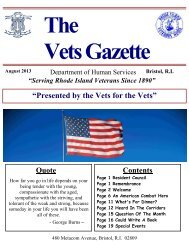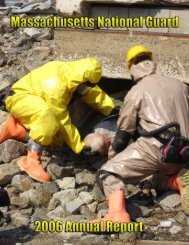Appendix K - Tungsten Information - STATES
Appendix K - Tungsten Information - STATES
Appendix K - Tungsten Information - STATES
You also want an ePaper? Increase the reach of your titles
YUMPU automatically turns print PDFs into web optimized ePapers that Google loves.
-- --<br />
Entry to and Elimination from the Body<br />
<strong>Tungsten</strong> that enters the body associated with food and drinking water is rapidly taken up into the blood<br />
and transported into all parts of the body. It is then eliminated from the body through the urine. Much<br />
of the tungsten that did not go into the blood stream from the inhalation or ingestion pathways leaves<br />
the body through the feces. A small amount of the tungsten that enters the blood may go into the bones,<br />
hair and fingernails and stay there for a while. Some of this tungsten slowly leaves the body through the<br />
urine and feces. <strong>Tungsten</strong> in the blood of a pregnant mother can enter the blood of the fetus in the<br />
womb. <strong>Tungsten</strong> may also enter the milk which could be a route of exposure for breastfeeding infants.<br />
Health Effects of <strong>Tungsten</strong> and Its Compounds<br />
The toxicity of tungsten, like any toxin, depends on the route of administration, the chemical form of<br />
the metal, the dose, the solubility of tungsten compounds and the duration of exposure. The more soluble<br />
tungsten compounds (e.g., sodium tungstate) appear to be more toxic than the insoluble ones (e.g.,<br />
tungsten carbide and tungsten oxides).<br />
<strong>Tungsten</strong> has no known beneficial effects on human health. Work in occupations with exposures to<br />
"hard" metals, which include but are not limited to tungsten, has been associated with a variety of<br />
adverse effects. Workers in the hard metal industry where tungsten alloys containing other metals such<br />
as such as cobalt breathed air containing tUnf!stenand other substances had elevated levels of<br />
pulmonary fibrosis (scaring oflung tissues), and other respiratory effects including asthma,<br />
inflammation of tissues of the nose, and lung cancer. Memory loss and impaired vision and hearing<br />
have been associated with work in metal industries using tungsten and other metals. It is generally<br />
believed that health effects observed in hard metal workers are the result of exposure to cobalt and not<br />
tungsten. However, studies conducted in animals that were exposed to tungsten by inhalation or orally<br />
also suggest that tungsten metal could be toxic to the respiratory and nervous systems. There are some<br />
animal data that suggest that tungsten could cause adverse developmental and reproductive effects. An<br />
intermediate duration study in animals indicated that tungsten is toxic to the kidneys. At high<br />
concentrations tungsten compounds may cause eye and skin irritation and contact dermatitis.<br />
The cancer causing potential of tungsten and its toxicity to the genetic material (genotoxicity) has not<br />
been extensively assessed. Sodium tungstate was found to be genotoxic in some test systems and nongenotoxic<br />
in some other test systems. In a single study, orally administered sodium tungstate was found<br />
not to be carcinogenic in rats. In other studies, soluble tungsten enhanced the carcinogenic potential of<br />
other known carcinogens. <strong>Tungsten</strong> alloy containing nickel and cobalt implanted in the muscle of rats<br />
produced cancers at the site of implantation. The cancerous cells metastasized to the lungs. Nickel implanted<br />
in rats also produced the same kind of muscle tumor, however, there were no metastases to the<br />
lungs.<br />
Recent information from Nevada has drawn attention to tungsten's potential toxicity. Data have shown<br />
elevated tungsten body burdens in residents of Fallon, NV (http://www.cdc.gov/nceh/clusters/Fallon),<br />
increased tungsten content in tree core samples in Sierra Vista, AZ and a childhood leukemia cluster in<br />
both communities (and also a nearby military base). Exposures to tungsten have not been conclusively<br />
linked to the cancers at either location. This information and the overall limited database on tungsten's<br />
toxicity have led the Centers for Disease Control and Prevention's National Center for Environmental<br />
Health (NCEH) to recommend tungsten and tungsten compounds for toxicology and carcinogenesis<br />
studies (http://ntp.niehs.nih.gov/ntplhtdocs/Chem_Background/ExSumPdf/tungsten.pdf.).Animal<br />
studies are now a priority for toxicology testing under the National Toxicology Program.<br />
OFFICE OF RESEARCH AND STANDARDS 2
















